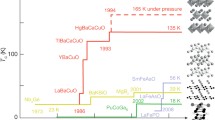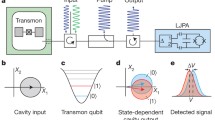Abstract
Traditionally, there has been a clear distinction between classical systems and quantum systems, particularly in the mathematical theories used to describe them. In our recent work on macroscopic quantum systems, this distinction has become blurred, making a unified mathematical formulation desirable, so as to show up both the similarities and the fundamental differences between quantum and classical systems. This paper serves this purpose, with explicit formulations and a number of examples in the form of superconducting circuit systems. We introduce three classes of physical systems with finite degrees of freedom: classical, standard quantum, and mixed quantum, and present a unified Hilbert space treatment of all three types of system. We consider the classical/quantum divide and the relationship between standard quantum and mixed quantum systems, illustrating the latter with a derivation of a superselection rule in superconducting systems.
Similar content being viewed by others
REFERENCES
K. K. Wan, Can. J. Phys. 58, 976 (1980).
B. van Fraassen, Quantum Mechanics (Clarendon, Oxford, 1992).
B. Beltrametti and G. Cassinelli, The Logic of Quantum Mechanics (Addison-Wesley, Reading, MA, 1981).
G. L. Sewell, Quantum Theory of Collective Phenomena (Clarendon, Oxford, 1986), pp. 13, 33, 41.
O. Bratteli and D. W. Robinson, Operator Algebras and Quantum Statistical Mechanics, Vol. I (Springer, New York, 1979), p. 60, Proposition 2.3.24.
R. Cirelli and F. Gallone, Ann. Inst. H. Poincaré 19A, 297 (1973).
R. Cirelli, F. Gallone, and B. Gubbay, J. Math. Phys. 16, 201 (1975).
N. P. Landsman, Int. J. Mod. Phys. A 6, 5349 (1991).
W. H. Zurek, Phys. Rev. D 26, 1862 (1982).
I. Percival and D. Richards, Introduction to Dynamics (Cambridge University Press, Cambridge, 1982).
L. Perko, Differential Equations and Dynamical Systems (Springer, New York, 1991).
T. Alanson, Phys. Lett. A 163, 41 (1992).
K. Kowalski, Methods of Hilbert Spaces in the Theory of Nonlinear Dynamics (World Scientific, Singapore, 1994), pp. 23–27.
B. O. Koopman, Proc. Nat. Sci. 17, 315 (1931).
M. Read and B. Simon, Methods of Modern Mathematical Physics, Vol. 4, Fourier Analysis Self-adjointness (Academic, New York, 1975), p. 313.
A. C. Rose-Innes and E. H. Rhoderick, Introduction to Superconductivity (Pergamon, London, 1969), p. 11.
H. Goldstein, Classical Mechanics (Addison-Wesley, Reading, MA, 1950), pp. 259, 273.
J. M. Jauch, Helv. Phys. Acta 37, 293 (1964).
P. Busch, P. Lahti, and P. Mittelstaedt, The Quantum Theory of Measurement (Springer, Berlin, 1996), pp. 18, 28.
T. N. Sherry and E. C. G. Sudarshan, Phys. Rev. D 18, 4590–4589 (1978).
T. N. Sherry and E. C. G. Sudarshan, Phys. Rev. D 20, 857–868 (1979).
K. K. Wan and F. E. Harrison, Phys. Lett. A 174, 1 (1993).
K. K. Wan, R. H. Fountain, and Z. Y. Tao, J. Phys. A 28, 2375–2393 (1995).
K. K. Wan and R. H. Fountain, Found. Phys. 26, 1165–1199 (1996).
F. E. Harrison and K. K. Wan, J. Phys. A 30, 4731–4755 (1997).
K. K. Wan and R. H. Fountain, Int. J. Theor. Phys. 37, 2153–2186 (1998).
R. P. Feynman, The Feynman Lectures on Physics, Vol. III (Addison-Wesley, New York, 1965), Sect. 21-9.
R. P. Feynman, Statistical Mechanics (Benjamin, Reading, MA, 1972), p. 304.
J. C. Gallop, SQUIDS, The Josephson Effects and Superconducting Electronics (Hilger, Bristol, 1991).
J. Bardeen, L. N. Cooper, and J. R. Schrieffer, Phys. Rev. 108, 1175 (1957).
D. R. Tilley and J. Tilley, Superfluidity and Superconductivity (Hilger, Bristol, 1990), p. 36.
N. N. Bogoliubov, Lectures on Quantum Statistics (MacDonald, London, 1970), Vol. 2, Part 2.
N. N. Bogoliubov and N. N. Bogliubov, Jr, An Introduction to Quantum Statistical Mechanics (Gordon & Breach, Lausanne, Switzerland, 1992), pp. 359–366.
G. Rickayzen, Theory of Superconductivity (Interscience, New York, 1965), p. 158.
A. S. Wightman and N. Glance, Nucl. Phys. B (Proc. Suppl.) 6, 202 (1989).
H. Primas and U. Muller-Herold, In Advances in Chemical Physics, Vol. 38, Chapt. 1-6 (1978).
H. Primas, Chemistry, Quantum Mechanics and Reductionism (Springer, Berlin, 1983).
H. Grabert and M. H. Devoret, Single Charge Tunneling: Coulomb Blockade Phenomena in Nanostructures (Plenum, New York, 1992).
K. K. Wan and R. G. D. McLean, J. Phys. A 17, 825–836 (1984).
K. K. Wan and R. G. D. McLean, J. Phys. A 17, 837–846, 2363 (1984).
J. Dixmier, Von Neumann Algebras (North-Holland, Amsterdam, 1981), pp. 161–240.
E. Merzbacher, Quantum Mechanics, 2nd edn. (Wiley, New York, 1972), p. 542.
N. I. Akhiezer and I. M. Glazman, Theory of Linear Operators in Hilbert Space, Vol. 1 (Ungar, New York, 1961), p. 82, 111.
N. I. Akhiezer and I. M. Glazman, Theory of Linear Operators in Hilbert Space, Vol. 2 (Ungar, New York, 1963), pp. 103–107, 77.
E. Prugovecki, Quantum Mechanics in Hilbert Spaces (Academic, New York, 1981), p. 261, Chap. 4, Section 3.
P. Roman, Some Modern Mathematics for Physicists and Other Outsiders (Pergamon, New York, 1975), Vol. 2, p. 457.
C. W. Burrel, Measure, Integration, and Probability (McGraw–Hill, New York, 1972), pp. 93, 29.
A. Papoulis, Probability, Random Variables and Stochastic Processes (McGraw–Hill, New York, 1965).
M. Guenin, J. Math. Phys. 7, 271–282 (1966).
C. Piron, Foundations of Quantum Physics (Benjamin, Reading, MA, 1976).
H. Araki, Prog. Theor. Phys. 64, 719–730 (1980).
V. Bargmann, Ann. Math. 59, 1 (1954).
F. A. Kaempffer, Concepts in Quantum Mechanics (Academic, New York, 1965), pp. 59–63, 341–346.
L. Fonda and G. C. Ghirardi, Symmetry Principles in Quantum Physics (Dekker, New York, 1970), pp. 84–89.
S. R. Corley and O. W. Greenberg, J. Math. Phys. 38, 571 (1997).
C. G. Kuper, Theory of Superconductivity (Clarendon, Oxford, 1968), pp. 213–216.
Rights and permissions
About this article
Cite this article
Wan, K.K., Bradshaw, J., Trueman, C. et al. Classical Systems, Standard Quantum Systems, and Mixed Quantum Systems in Hilbert Space. Foundations of Physics 28, 1739–1783 (1998). https://doi.org/10.1023/A:1018838919685
Issue Date:
DOI: https://doi.org/10.1023/A:1018838919685




